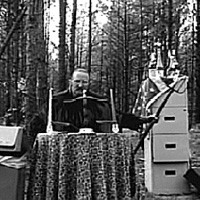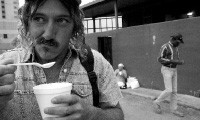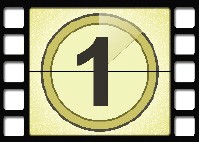Phil Chambliss: Auteur from Arkansas
Special program
Saturday, October 14th, 5:15 p.m.
After making movies in obscurity for decades, using cheap equipment and a cast of friends and co-workers, Camden, Arkansas, native Phil Chambliss has become a minor cause celebre on the film festival circuit. Chambliss, who has written, directed, shot, edited, and scored 27 films over the past three decades, received his first public screening at the 2004 Nashville Film Festival and will be celebrated at the British Film Institute’s 50th London Film Festival later this month.
Dubbed a “folk art filmmaker,” Chambliss’ ostensibly amateurish, rural-based, borderline surreal short films are so odd, there’s a temptation to file them under “so bad they’re good,” if not just plain bad. But there’s something real happening in Chambliss’ work, at least in the three examples being screened at Indie Memphis.
The 1982 “thriller” Shadow of the Hatchet Man is the most memorable of the bunch. It’s shot in gloriously grimy 8mm black and white, which lends an effectively nasty tone to an already disreputable tale of a hatchet-wielding killer and the cheating husband who sees in the furor an opportunity to off his wife. From the pungent, intentionally loony, and well-observed dialogue (“I can see she was a cute l’il ole girl,” a newscaster — played by Chambliss — drawls during a report on the latest hatchet killer victim) to such memorably odd images as a bare-chested sheriff reporting from in front of an Arkansas flag, Shadow of the Hatchet Man is hard to forget.
The other two shorts being shown as part of this program aren’t quite as absorbing, but are still memorable. Mr. Visit Show (2002) depicts a reporter investigating rumors that the “Bird-Mart Day Care Center for Birds” is using sleeping pellets instead of seed, and ends with probably the most hilariously unstrenuous fist-fight in movie history.
Even better is 1986’s The Devil’s Helper, in which two good ole boys out in the deer woods run into one of Satan’s minions and cut a deal for expanded hunting privileges. The Devil’s Helper opens with a still shot of a giant buck, presenting the deer as a creature of awe, like a god. If you grew up around the culture of rural deer hunting (I was born in December — the lore goes that I was the only thing able to pull my older male relatives out of “camp”), you’re liable to react to the image with a laugh of recognition.
Chambliss will attend the screening. — Chris Herrington

A Reel Man
Special program
Wednesday, October 18, 8:30 p.m.
Skip Eisheimer was a film geek who chanced into 500 educational filmstrips from the 1930s to 1970s. A collector was born and, thousands of strips later, cineastes everywhere can rejoice. Eisheimer formed A/V Geeks, a group based in Raleigh, North Carolina, that takes these almost-forgotten artifacts and publicly screens them. The reaction to these strips ranges from recognition to horror to delight. A Reel Man tells Eisheimer’s story and, better yet, shows clips of some his filmstrips. Eisheimer is a kind of archaeologist, digging through the dusty discards of libraries, schools, and government agencies and resurrecting the celluloid bones he discovers there. Some of the best of these strips — More Dates for Kay, Why Vandalism? — are educational to current-day audiences, illuminating some of the ideals and mores that kids in the mid-20th century were exposed to. It raises the question: How did those generations escape deep emotional scarring? One can only hope they laughed at these films like audiences do today. And laugh you will: There’s a clearly zonked Sonny Bono lecturing on teenage pot use. In Alcohol is Dynamite, there are lines such as, “Like dope addicts, one drinker can’t stand the sight of somebody not drinking.” There’s the titular, faux-Johnny Cash country song for Shake Hands with Danger. And there are Bizarro World home truths like “It’s not sissy to be clean.” In addition to the screening of the documentary, Eisheimer will appear at the festival and will show some of his films, making this a don’t-miss event on the program. — Greg Akers
American Cannibal: The Road to Reality
Beyond the South Documentary
Sunday, October 15th, 5 p.m.
American Cannibal: The Road To Reality is such a devastating — and devastatingly funny — film about Hollywood’s sleazy underbelly, it’s difficult to imagine that it wasn’t co-scripted by David Mamet and Christopher Guest. But, no. It’s a real documentary about Gil Riply and Dave Roberts, two idealistic kids determined to make it in the entertainment industry if it kills them. After a pilot for Comedy Central fails, the duo turns to Kevin Blatt, the pornographer who distributed the Paris Hilton sex tape, to produce a reality show called American Cannibal, where starving contestants engage in grueling challenges for food in an exotic, if not particularly scenic, locale where cannibalism is legal. Things quickly go from bad to as bad as it can get, and Riply and Roberts are in way over their heads. — Chris Davis
The Bridge
Hometowner Feature
Monday, October 16th, 8:45 p.m.
This locally produced feature directed by Brett Hanover uses materials created by the Church of Scientology and stories told by former members of L. Ron Hubbard’s controversial sci-fi religion to build a tragic narrative about misplaced faith and insidious fraud. Scientologists will hate it. People who hate Scientologists won’t like it nearly as much as the Tom Cruise episode of South Park. — CD
Cocaine Cowboys
Soul of Southern Film Documentary
Monday, October 16th, 6:30 p.m.
Audacious research and fierce editing are the standouts in Cocaine Cowboys, a documentary that chronicles the roots, heyday, and consequences — bad and good — of the cocaine trade in Miami. The city was relatively quiet in the early 1950s, but, in succession, gunrunning, rum running, marijuana trafficking, and Cuban immigration led to the cocaine-trade explosion in the ’70s. Among the significant notes is that Pittsburgh Steelers players were doing coke in the days leading to their Super Bowl game against the Dallas Cowboys in Miami in 1976. The Steelers, of course, won the game. Cocaine Cowboys doesn’t just give an overview, but focuses on individuals and their fates. Its conclusion seems inarguable: The skyline of Miami today owes more than a little to cocaine. — GA
Delusions
Hometowner Feature
Monday, October 16th, 8:30 p.m.
Delusions kicks off with drugs, rape, and prostitution, and the title credits that follow are reminiscent of the opening of The Sopranos. It doesn’t get any less bleak from there. In the movie, Memphis is a town populated by evil men, losers, and worse, and the innocent don’t remain so for long. A drug dealer (Chris Ross) and a sweet-natured virgin (Tiffany Pemberton, in a brave, gutsy performance) cross paths and have a romance that sours in devastating ways. A debt enforcer (Bevan Bell) completes the triangle, and soon enough no one remains innocent. Written and directed by Robert Saba, Delusions is a kind of would-be Bluff City Requiem for a Dream. — GA
Fraternity Massacre at Hell Island
Hometowner Feature
Monday, October 16th, 6:45 p.m.
Local filmmaker Mark Jones established himself on the local scene five years ago with his polished screwball comedy debut, Eli Parker Is Getting Married? This follow-up feature is a gay-themed horror-comedy spoof. Jones, who wrote and directed the film, reunites with his Eli Parker collaborator Ryan Parker, who serves as the editor and director of photography on Fraternity Massacre at Hell Island. The plot concerns a fraternity “hell night” staged at Hell Island (Mud Island), which had witnessed a multiple murder on the 4th of July 20 years earlier. Protagonist Jack (Tyler Farrell) is a gay pledge whose sexuality is known only to his also-closeted frat-brother boyfriend (Michael Gravois). On hell night, Jack has to worry about more than ghosts and fraternity hazing; there’s also a murderous clown on the loose, which has nothing on the perils of being in the closet while in the frat. Because of the gay theme, Fraternity Massacre at Hell Island is able to spoof both the sexualized atmosphere of slasher movies and real-life fraternities. Jones’ movie tackles these issues with a light comic touch that will be familiar to anyone who’s seen Eli Parker Is Getting Married? At the end, Jack’s frat has been turned upside down and features a “token straight brother.” — CH
Grim Sweeper
Hometowner Feature
Tuesday, October 17th, 8:30 p.m.
I like to think that a lot of people first get into independent filmmaking so that they can play with fake blood. I don’t know if this true in the case of Edward Valibus Phillips, director of the locally produced Grim Sweeper. But his movie features gobs of perfect fake blood, brains, and bone — enough to inspire a whole gaggle of new filmmakers. Grim Sweeper follows Hal (Phillips) and his pal Rod (Benjamin Rednour) as they punch the clock on a job that is both familiar (the bland humdrum of hourly wage employment with coworkers who are annoying) and alien (the duo clean human gristle from crime and death scenes). Gallows humor reigns as Rednour steals the show with his acting and Phillips reinforces the wit of the endeavor with with confident visual observations. — GA
The Importance of Being Russell
Hometowner Feature
Thursday, October 19th, 6:45 p.m.
This local feature unites two known forces on the Memphis film scene, the Paradox Productions crew responsible for the ambitious feature Strange Cargo a few years ago and actor/writer John Pickle, creator and star of the cable access skit show Pickle TV. The pair previously collaborated on the short film The Last Man on Earth, but this comedic fantasy-farce is their first feature. Pickle plays “redneck” inventor Russell Hawker (among his many great ideas is fashioning a “shotgun silencer” by duct-taping a pillow over the barrel), unhappily married, professionally frustrated, and coming up on his 10th wedding anniversary.
Pickle’s Jim Varney-esque hick character is a confident creation who holds the screen and provokes some actual laughs. The film also boasts some good ideas, such as the neat symmetry and casual critique when Russell and his wife sit down to breakfast opposite one another and separately watch the same program on adjacent televisions. The Importance of Being Russell works well early on, finding humor in its backwoods setting without being condescending, but despite a well-staged combat scene (that’s right — a combat scene!), it loses its footing a little as the plot becomes more fantastical. But it’s handsomely shot (by Paradox’s Jeff Hassen) and well made (Sean Plemmons directs, Jeff Bryant produces) throughout. — CH
Old Joy
Beyond the South Feature
Sunday, October 15th, 7 p.m.
This well-reviewed indie feature from writer-director Kelly Reichardt follows two friends (Will Oldham and Daniel London) who reunite for a weekend camping trip in Oregon’s Cascade mountain range and confront where they are in their divergent lives. Old Joy is set for an official release next month, but since a local theatrical run seems like a longshot, this might be your only chance to see it on the big screen. — CH
Playing With Rage
Soul of Southern Film Documentary
Thursday, October 19th, 6:30 p.m.
Female stereotypes are smashed to bits in Playing With Rage, a feature length documentary about a disillusioned sportswriter who rediscovers his love for competitive athletics after following the ups and downs of a professional female football team from Texas. What begins as shades of Sherman’s March quickly evolves from a self-pitying account of the filmmaker’s burnout into a seriously engaging meditation on gender roles and sports in the American heartland. — CD
Stomp! Shout! Scream!
Soul of Southern Film Feature
Saturday, October 14th, 1 p.m.
The tagline of Stomp! Shout! Scream! describes the movie as “A Beach Party Rock & Roll Monster Movie.” The beach is in 1960’s Georgia. The rock-and-roll is mainly provided by the fuzzed-out garage rock of Catfight! The monster is the Skunk Ape, an allegedly real-life Everglades Bigfoot, described by a plant-biologist character in the movie as an “antediluvian simian creature.” The tone of the film is like The Lost Skeleton of Cadavra, another recent homage to Atomic Age creature features, but in this case it’s more camp than overt comedy. In the movie, a guy in a suit — I mean, the mysterious Skunk Ape — menaces a small town and, like that other famous cinematic monkey, falls for a girl. — GA
What Goes Around …
Hometowner Feature
Tuesday, October 17th, 8:45 p.m.
The end of the credits for What Goes Around … states, “No animals, crackheads, or film geeks were harmed in the making of this film.” I can’t say I remember seeing any crackheads, and I’m pretty sure there weren’t any animals, but such are the quality and interests of the film that there’s no doubt it’s full of film geeks. The story is simple and universal: Talal (Patrick Henry) has been with girlfriend Marie (Chris Brown) for years, but realizes he’s philophobic — afraid of commitment. It isn’t so much Talal’s feet that are clay as his heart. When he meets Angela (Lisa Miller), he’s smitten and drops Marie for her, an action that has unforeseen and heartbreaking consequences. The film bursts with Chow Yun Fat and Rudy Ray Moore references and, in featuring the now-defunct Parallax Video as a location, provides a fitting coda to that downtown establishment. Best of all, Memphis has never looked so romantic as when Talal and Angela hit the town on a first date, their burgeoning relationship captured with black-and-white photography and Billie Holiday’s “Solitude” washing over it all. It doesn’t seem so hard to imagine the Bluff City as New York in a ’40s or ’50s film. — GA



